New Mexico to Southern California: The Old Spanish Trail, Explained

Although Southern California today is a region teeming with millions, for much of its history it was a remote outpost of the vast Spanish Empire. Nearly 227 years passed between Juan Rodríguez Cabrillo's first exploration of the California coast in 1542 and Gaspar de Portolá's establishment of the Presidio of San Diego in 1769. Then, for another sixty years, Southern California grew in relative isolation from the rest of Hispanic civilization. Finally, in 1829, an intrepid merchant opened a trade route—today known as the Old Spanish Trail—between Los Angeles and Santa Fe, creating Southern California's first overland link with the older Spanish settlements of New Mexico.
From June 2-5, historians, archivists, and representatives from government agencies and the Hispanic and Native American communities will gather in Pomona at the 2011 Old Spanish Trail Association annual conference to explore the history of the trail in California.
More on Accessing Southern California
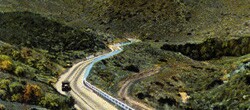
Many Roads to the Historical Southland: Natural barriers isolate Los Angeles from the rest of the continent on three sides
In the late nineteenth century, hundreds of miles of unforgiving terrain and harsh climate divided Southern California from New Mexico, but both stood to profit from a direct trade route.
Alta California then formed, along with the province of New Mexico, the northern boundary of the Viceroyalty of New Spain. The recently-colonized Spanish territory boasted fine natural harbors in San Francisco and San Diego. But with its location at the northern extreme of the Spanish Empire, and surrounded by inhospitable desert to the east and southeast, Southern California was effectively isolated from the political and cultural center of Mexico City to the south.
To the east, the older Spanish province of New Mexico, first settled in 1598, offered California integration with the burgeoning United States and the Mexican heartland via established overland trade routes. For Southern California's rancheros, New Mexico also represented an untapped market for the region's abundant supply of horses and mules. From the point of view of landlocked New Mexico, a trade route to Southern California represented not only a potential market for Santa Fe's serapes and other handmade goods, but also a connection to foreign markets via California's ports.
Almost as soon as the first Spanish settlements arose in California, efforts were made to bridge the chasm and link the two provinces. A team of Franciscan missionaries left Santa Fe for California in 1776, but made it only as far as Utah Lake, near the present-day city of Provo.
In 1826, American fur trapper and explorer Jedediah Smith blazed a trail from present-day Utah to the Mojave Desert. After a clash with hostile Mohave Indians, Smith met two Tongva guides who offered to take his expedition to Mission San Gabriel, near Los Angeles. The guides led Smith along the intermittent Mohave River and over the San Bernardino Mountains near the Cajon Pass. Smith's party arrived at the mission on November 27, where they were warmly received by the missionaries, as depicted in the scene below.
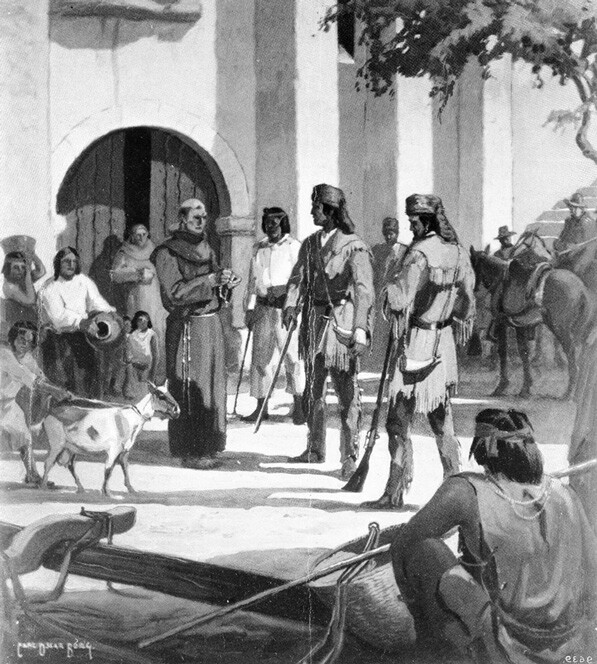
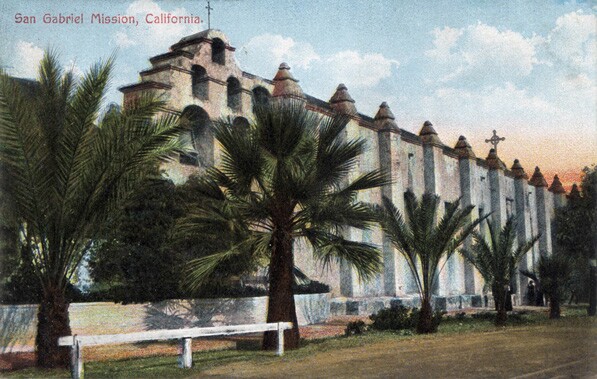
Three years later, Santa Fe merchant Antonio Armijo led the first successful caravan from Santa Fe to Southern California, combining Smith's route with portions of the Franciscans' 1776 path to Utah to open what would later be called the Old Spanish Trail. In doing so, Armijo had established an important link between California and New Mexico, now the northern flanks of the newly-independent Mexican Republic.
Elizabeth von Till Warren, a historian of the Old Spanish Trail, writes of the new route's effect:
News of the opening of trade with California resulted in immediate commerce between Santa Fe and Los Angeles. With a few exceptions, pack trains made annual treks between New Mexico and California, bringing woven Mexican products to California, which lacked sheep, and bartering them for horses and mules, scarce in New Mexico.
The trail carried mule-trains over the Cajon Pass, then west through Rancho Cucamonga, Upland, and El Monte, to the region's major settlements at Mission San Gabriel and Los Angeles. There the traders unloaded their goods, many of which were sold at the Los Angeles Plaza, pictured below in a nineteenth century photograph from UC Berkeley's Bancroft Library.
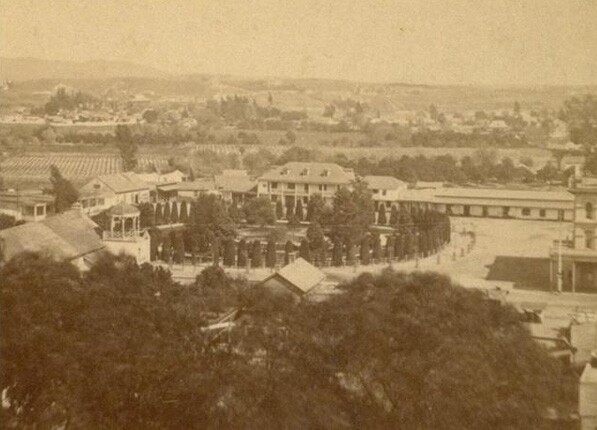
The increased commerce hid a dark and ugly side to the trail's establishment, according to von Till Warren:
Raids for Indian slaves became common, with victims sold at either end of the trail despite official condemnation of the practice. The traffic in human beings reverberated among the peoples who lived along the trail for many years longer than the caravans plied their trade.
The trail remained an important trade route for several years until, shortly after the American conquest of California, several competing routes comprised of wagon roads were opened. The Old Spanish Trail, which allowed only for pack animals, soon fell into disuse.
Today, monuments mark the trail's path through the Southland. In Upland, the Madonna of the Trail statue overlooks the route once taken by Santa Fe-bound traders. The monument, dedicated by the Daughters of the American Revolution in 1929, was one of twelve placed along the National Old Trails Road, which stretched from New York City to Los Angeles. In the Cajon Pass, an obelisk-shaped monument, dedicated in 1917, commemorates the early pioneers who traveled between Southern California and points east.
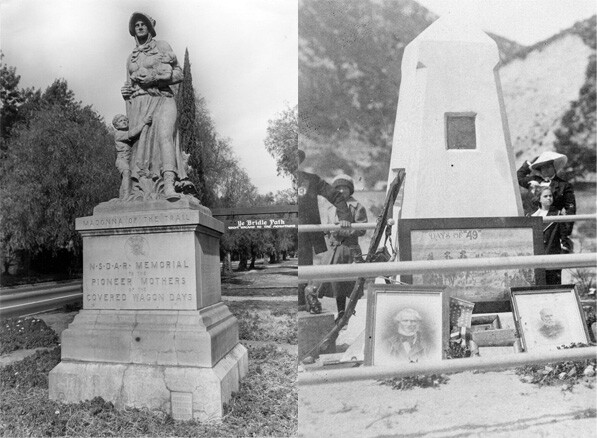
The trail's historical significance was further recognized in 2002, when an act of Congress, passed unanimously by both houses and signed by President George W. Bush, designated the corridor as the Old Spanish National Historic Trail and placed the historic route under the supervision of the National Park Service.

Many of the archives who contributed the above images are members of L.A. as Subject, an association of more than 230 libraries, museums, official archives, personal collections, and other institutions. Hosted by the USC Libraries, L.A. as Subject is dedicated to preserving and telling the sometimes-hidden stories and histories of the Los Angeles region. Our posts here will provide a view into the archives of individuals and cultural institutions whose collections inform the great narrative—in all its complex facets—of Southern California.